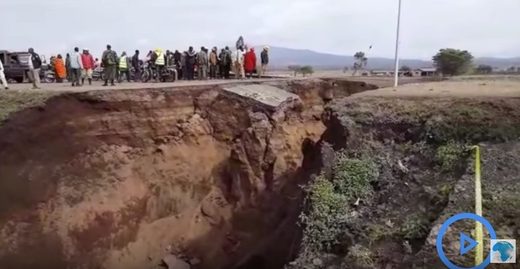
In mid-March, following an extended period of heavy rainfall, residents of the Mai Mahiu settlement in Kenya woke up to a big surprise – a massive crack in the Earth that appeared to have opened up almost overnight. Running several miles long and measuring 50 feet deep and 65 feet wide in some places, the terrifying fissure damaged several homes and caused a portion of the busy Mai Mahiu Narok-Nairobi highway to collapse.
The opening occurred along the East African Rift Valley, a 3,700-mile (6,000-kilometer) crack in the Earth that formed millions of years ago when the Nubian Plate, which encompasses almost the entire African continent, and smaller Somali Plate began pulling away from the Arabian Plate. Over the years, the two tectonic plates have been drifting apart, causing the rift to widen. Geologists believe that in about 50 million years, the Somali Plate, which includes nearly half of the East coast of Africa will completely break away from the Nubian Plate, forming a mini-continent, about the size of New Zealand, in the Indian Ocean.

Scientists are divided over the cause of the most recent crack. Its location along the Somali Plate has led some experts to speculate that it was caused by seismic activity, providing further validation of Africa’s eventual breakup. However, others are not sure. There were no earthquakes reported in the area, and a closer look at the images and videos of the fissure indicates the crack does not have the same outline, which means it would not fit like a puzzle if put back again. The crack is also not continuous, and the land on either side is flat, providing further evidence of the absence of tectonic activity. They therefore believe the chasm was the result of the inclement weather.
While many experts support the rainstorm theory, they are divided over how long the opening has been around. Ben Andrews, a geologist from the Smithsonian, thinks the chasm was created “hundreds of thousands of years” ago by tectonic plate movement, while the Kenya Geological Survey believes the opening is gullies created by groundwater. Both agree that the crack was revealed when the top layer of volcanic ash was washed away by the recent rain.

Then there are those who believe the crack is entirely new. “I think it’s an Earth fissure, the same sort of thing that you see in Arizona after heavy rainstorms,” said earthquake geologist Wendy Bohon. “They’re the result of heavier torrential rains that come and wash away large portions of the dirt in the ground...It wasn’t a result of tectonics; it was the result of the weather.” While researchers puzzle over the rift’s cause, residents are keeping a close eye on the ground, hoping there are no further surprise cracks in store for them.
Resources: National Geographic.com, Forbes.com, theweek.com, popularmechanics.com
